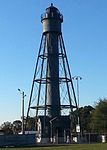2012 Paulsboro train derailment
2012 disasters in the United States2012 in New Jersey2012 industrial disastersAccidents and incidents involving ConrailAccidents and incidents involving Norfolk Southern Railway ... and 6 more
Chemical disastersDerailments in the United StatesEnvironmental disasters in the United StatesPaulsboro, New JerseyRailway accidents and incidents in New JerseyRailway accidents in 2012

On November 30, 2012, a daily freight train running on Conrail Shared Assets Operations Penns Grove Secondary derailed in Paulsboro, a borough with an industrial and maritime economy, in Gloucester County, New Jersey. As a result, vinyl chloride from one car leaked into the air. In 2023 several news reports drew parallels between this derailment and the 2023 Ohio train derailment in East Palestine, Ohio, which also involved release of vinyl chloride.
Excerpt from the Wikipedia article 2012 Paulsboro train derailment (License: CC BY-SA 3.0, Authors, Images).2012 Paulsboro train derailment
Mantua Avenue,
Geographical coordinates (GPS) Address Nearby Places Show on map
Geographical coordinates (GPS)
| Latitude | Longitude |
|---|---|
| N 39.834609 ° | E -75.236786 ° |
Address
Mantua Avenue
08066
New Jersey, United States
Open on Google Maps




